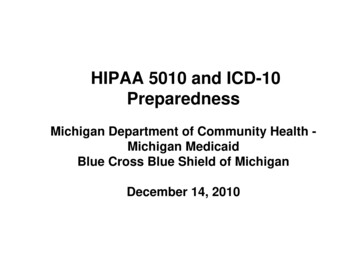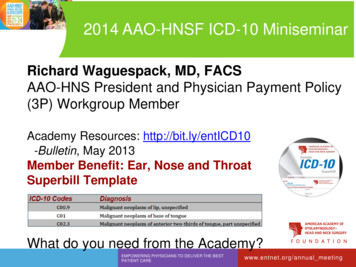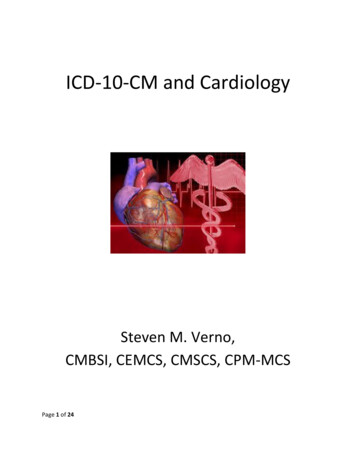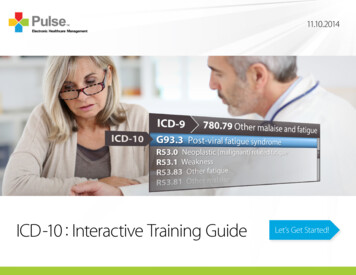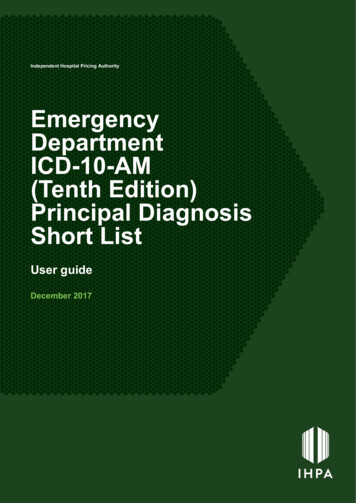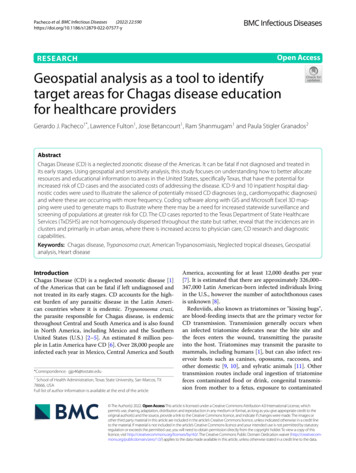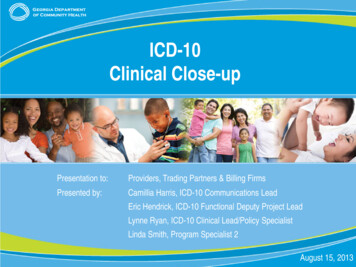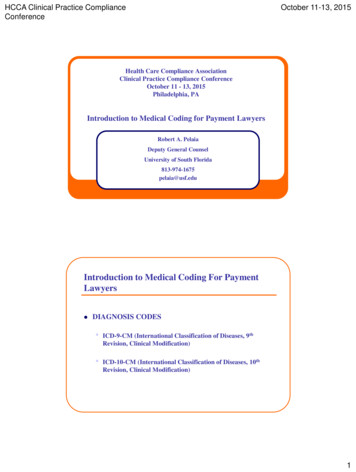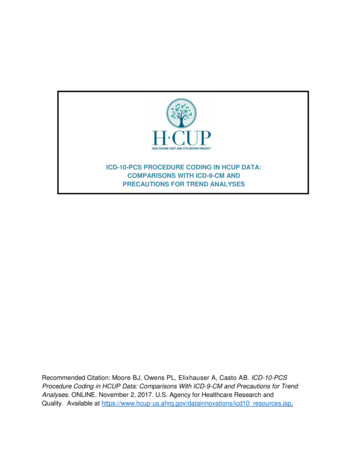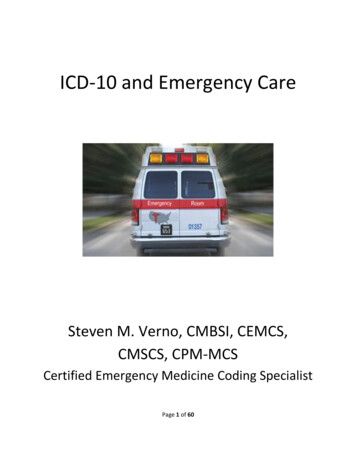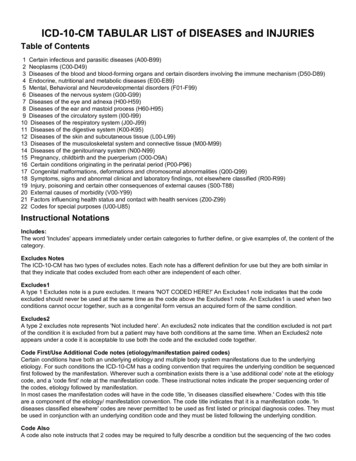
Transcription
ICD-10-CM TABULAR LIST of DISEASES and INJURIESTable of Contents1 Certain infectious and parasitic diseases (A00-B99)2 Neoplasms (C00-D49)3 Diseases of the blood and blood-forming organs and certain disorders involving the immune mechanism (D50-D89)4 Endocrine, nutritional and metabolic diseases (E00-E89)5 Mental, Behavioral and Neurodevelopmental disorders (F01-F99)6 Diseases of the nervous system (G00-G99)7 Diseases of the eye and adnexa (H00-H59)8 Diseases of the ear and mastoid process (H60-H95)9 Diseases of the circulatory system (I00-I99)10 Diseases of the respiratory system (J00-J99)11 Diseases of the digestive system (K00-K95)12 Diseases of the skin and subcutaneous tissue (L00-L99)13 Diseases of the musculoskeletal system and connective tissue (M00-M99)14 Diseases of the genitourinary system (N00-N99)15 Pregnancy, childbirth and the puerperium (O00-O9A)16 Certain conditions originating in the perinatal period (P00-P96)17 Congenital malformations, deformations and chromosomal abnormalities (Q00-Q99)18 Symptoms, signs and abnormal clinical and laboratory findings, not elsewhere classified (R00-R99)19 Injury, poisoning and certain other consequences of external causes (S00-T88)20 External causes of morbidity (V00-Y99)21 Factors influencing health status and contact with health services (Z00-Z99)22 Codes for special purposes (U00-U85)Instructional NotationsIncludes:The word 'Includes' appears immediately under certain categories to further define, or give examples of, the content of thecategory.Excludes NotesThe ICD-10-CM has two types of excludes notes. Each note has a different definition for use but they are both similar inthat they indicate that codes excluded from each other are independent of each other.Excludes1A type 1 Excludes note is a pure excludes. It means 'NOT CODED HERE!' An Excludes1 note indicates that the codeexcluded should never be used at the same time as the code above the Excludes1 note. An Excludes1 is used when twoconditions cannot occur together, such as a congenital form versus an acquired form of the same condition.Excludes2A type 2 excludes note represents 'Not included here'. An excludes2 note indicates that the condition excluded is not partof the condition it is excluded from but a patient may have both conditions at the same time. When an Excludes2 noteappears under a code it is acceptable to use both the code and the excluded code together.Code First/Use Additional Code notes (etiology/manifestation paired codes)Certain conditions have both an underlying etiology and multiple body system manifestations due to the underlyingetiology. For such conditions the ICD-10-CM has a coding convention that requires the underlying condition be sequencedfirst followed by the manifestation. Wherever such a combination exists there is a 'use additional code' note at the etiologycode, and a 'code first' note at the manifestation code. These instructional notes indicate the proper sequencing order ofthe codes, etiology followed by manifestation.In most cases the manifestation codes will have in the code title, 'in diseases classified elsewhere.' Codes with this titleare a component of the etiology/ manifestation convention. The code title indicates that it is a manifestation code. 'Indiseases classified elsewhere' codes are never permitted to be used as first listed or principal diagnosis codes. They mustbe used in conjunction with an underlying condition code and they must be listed following the underlying condition.Code AlsoA code also note instructs that 2 codes may be required to fully describe a condition but the sequencing of the two codes
is discretionary, depending on the severity of the conditions and the reason for the encounter.7th characters and placeholder XFor codes less than 6 characters that require a 7th character a placeholder X should be assigned for all characters lessthan 6. The 7th character must always be the 7th character of a code
Chapter 1Certain infectious and parasitic diseases (A00-B99)Includes: diseases generally recognized as communicable or transmissibleUse additional code to identify resistance to antimicrobial drugs (Z16.-)Excludes1: certain localized infections - see body system-related chaptersExcludes2: carrier or suspected carrier of infectious disease (Z22.-)infectious and parasitic diseases complicating pregnancy, childbirth and the puerperium (O98.-)infectious and parasitic diseases specific to the perinatal period (P35-P39)influenza and other acute respiratory infections (J00-J22)This chapter contains the following blocks:A00-A09Intestinal infectious diseasesA15-A19TuberculosisA20-A28Certain zoonotic bacterial diseasesA30-A49Other bacterial diseasesA50-A64Infections with a predominantly sexual mode of transmissionA65-A69Other spirochetal diseasesA70-A74Other diseases caused by chlamydiaeA75-A79RickettsiosesA80-A89Viral and prion infections of the central nervous systemA90-A99Arthropod-borne viral fevers and viral hemorrhagic feversB00-B09Viral infections characterized by skin and mucous membrane lesionsB10Other human herpesvirusesB15-B19Viral hepatitisB20Human immunodeficiency virus [HIV] diseaseB25-B34Other viral diseasesB35-B49MycosesB50-B64Protozoal diseasesB65-B83HelminthiasesB85-B89Pediculosis, acariasis and other infestationsB90-B94Sequelae of infectious and parasitic diseasesB95-B97Bacterial and viral infectious agentsB99Other infectious diseasesIntestinal infectious diseases (A00-A09)A00 CholeraA00.0 Cholera due to Vibrio cholerae 01, biovar choleraeClassical choleraA00.1 Cholera due to Vibrio cholerae 01, biovar eltorCholera eltorA00.9 Cholera, unspecifiedA01 Typhoid and paratyphoid feversA01.0 Typhoid feverInfection due to Salmonella typhiA01.00 Typhoid fever, unspecifiedA01.01 Typhoid meningitisA01.02 Typhoid fever with heart involvement
Typhoid endocarditisTyphoid myocarditisA01.03 Typhoid pneumoniaA01.04 Typhoid arthritisA01.05 Typhoid osteomyelitisA01.09 Typhoid fever with other complicationsA01.1 Paratyphoid fever AA01.2 Paratyphoid fever BA01.3 Paratyphoid fever CA01.4 Paratyphoid fever, unspecifiedInfection due to Salmonella paratyphi NOSA02 Other salmonella infectionsIncludes: infection or foodborne intoxication due to any Salmonella species other than S. typhi and S. paratyphiA02.0 Salmonella enteritisSalmonellosisA02.1 Salmonella sepsisA02.2 Localized salmonella infectionsA02.20 Localized salmonella infection, unspecifiedA02.21 Salmonella meningitisA02.22 Salmonella pneumoniaA02.23 Salmonella arthritisA02.24 Salmonella osteomyelitisA02.25 Salmonella pyelonephritisSalmonella tubulo-interstitial nephropathyA02.29 Salmonella with other localized infectionA02.8 Other specified salmonella infectionsA02.9 Salmonella infection, unspecifiedA03 ShigellosisA03.0 Shigellosis due to Shigella dysenteriaeGroup A shigellosis [Shiga-Kruse dysentery]A03.1 Shigellosis due to Shigella flexneriGroup B shigellosisA03.2 Shigellosis due to Shigella boydiiGroup C shigellosisA03.3 Shigellosis due to Shigella sonneiGroup D shigellosis
A03.8 Other shigellosisA03.9 Shigellosis, unspecifiedBacillary dysentery NOSA04 Other bacterial intestinal infectionsExcludes1: bacterial foodborne intoxications, NEC (A05.-)tuberculous enteritis (A18.32)A04.0 Enteropathogenic Escherichia coli infectionA04.1 Enterotoxigenic Escherichia coli infectionA04.2 Enteroinvasive Escherichia coli infectionA04.3 Enterohemorrhagic Escherichia coli infectionA04.4 Other intestinal Escherichia coli infectionsEscherichia coli enteritis NOSA04.5 Campylobacter enteritisA04.6 Enteritis due to Yersinia enterocoliticaExcludes1: extraintestinal yersiniosis (A28.2)A04.7 Enterocolitis due to Clostridium difficileFoodborne intoxication by Clostridium difficilePseudomembraneous colitisA04.71 Enterocolitis due to Clostridium difficile, recurrentA04.72 Enterocolitis due to Clostridium difficile, not specified as recurrentA04.8 Other specified bacterial intestinal infectionsA04.9 Bacterial intestinal infection, unspecifiedBacterial enteritis NOSA05 Other bacterial foodborne intoxications, not elsewhere classifiedExcludes1: Clostridium difficile foodborne intoxication and infection (A04.7-)Escherichia coli infection (A04.0-A04.4)listeriosis (A32.-)salmonella foodborne intoxication and infection (A02.-)toxic effect of noxious foodstuffs (T61-T62)A05.0 Foodborne staphylococcal intoxicationA05.1 Botulism food poisoningBotulism NOSClassical foodborne intoxication due to Clostridium botulinumExcludes1: infant botulism (A48.51)wound botulism (A48.52)A05.2 Foodborne Clostridium perfringens [Clostridium welchii] intoxicationEnteritis necroticansPig-belA05.3 Foodborne Vibrio parahaemolyticus intoxicationA05.4 Foodborne Bacillus cereus intoxication
A05.5 Foodborne Vibrio vulnificus intoxicationA05.8 Other specified bacterial foodborne intoxicationsA05.9 Bacterial foodborne intoxication, unspecifiedA06 AmebiasisIncludes: infection due to Entamoeba histolyticaExcludes1: other protozoal intestinal diseases (A07.-)Excludes2: acanthamebiasis (B60.1-)Naegleriasis (B60.2)A06.0 Acute amebic dysenteryAcute amebiasisIntestinal amebiasis NOSA06.1 Chronic intestinal amebiasisA06.2 Amebic nondysenteric colitisA06.3 Ameboma of intestineAmeboma NOSA06.4 Amebic liver abscessHepatic amebiasisA06.5 Amebic lung abscessAmebic abscess of lung (and liver)A06.6 Amebic brain abscessAmebic abscess of brain (and liver) (and lung)A06.7 Cutaneous amebiasisA06.8 Amebic infection of other sitesA06.81 Amebic cystitisA06.82 Other amebic genitourinary infectionsAmebic balanitisAmebic vesiculitisAmebic vulvovaginitisA06.89 Other amebic infectionsAmebic appendicitisAmebic splenic abscessA06.9 Amebiasis, unspecifiedA07 Other protozoal intestinal diseasesA07.0 BalantidiasisBalantidial dysenteryA07.1 Giardiasis [lambliasis]A07.2 CryptosporidiosisA07.3 IsosporiasisInfection due to Isospora belli and Isospora hominisIntestinal coccidiosis
IsosporosisA07.4 CyclosporiasisA07.8 Other specified protozoal intestinal diseasesIntestinal microsporidiosisIntestinal trichomoniasisSarcocystosisSarcosporidiosisA07.9 Protozoal intestinal disease, unspecifiedFlagellate diarrheaProtozoal colitisProtozoal diarrheaProtozoal dysenteryA08 Viral and other specified intestinal infectionsExcludes1: influenza with involvement of gastrointestinal tract (J09.X3, J10.2, J11.2)A08.0 Rotaviral enteritisA08.1 Acute gastroenteropathy due to Norwalk agent and other small round virusesA08.11 Acute gastroenteropathy due to Norwalk agentAcute gastroenteropathy due to NorovirusAcute gastroenteropathy due to Norwalk-like agentA08.19 Acute gastroenteropathy due to other small round virusesAcute gastroenteropathy due to small round virus [SRV] NOSA08.2 Adenoviral enteritisA08.3 Other viral enteritisA08.31 Calicivirus enteritisA08.32 Astrovirus enteritisA08.39 Other viral enteritisCoxsackie virus enteritisEchovirus enteritisEnterovirus enteritis NECTorovirus enteritisA08.4 Viral intestinal infection, unspecifiedViral enteritis NOSViral gastroenteritis NOSViral gastroenteropathy NOSA08.8 Other specified intestinal infectionsA09 Infectious gastroenteritis and colitis, unspecifiedInfectious colitis NOSInfectious enteritis NOSInfectious gastroenteritis NOSExcludes1: colitis NOS (K52.9)diarrhea NOS (R19.7)enteritis NOS (K52.9)gastroenteritis NOS (K52.9)noninfective gastroenteritis and colitis, unspecified (K52.9)
Tuberculosis (A15-A19)Includes: infections due to Mycobacterium tuberculosis and Mycobacterium bovisExcludes1: congenital tuberculosis (P37.0)nonspecific reaction to test for tuberculosis without active tuberculosis (R76.1-)pneumoconiosis associated with tuberculosis, any type in A15 (J65)positive PPD (R76.11)positive tuberculin skin test without active tuberculosis (R76.11)sequelae of tuberculosis (B90.-)silicotuberculosis (J65)A15 Respiratory tuberculosisA15.0 Tuberculosis of lungTuberculous bronchiectasisTuberculous fibrosis of lungTuberculous pneumoniaTuberculous pneumothoraxA15.4 Tuberculosis of intrathoracic lymph nodesTuberculosis of hilar lymph nodesTuberculosis of mediastinal lymph nodesTuberculosis of tracheobronchial lymph nodesExcludes1: tuberculosis specified as primary (A15.7)A15.5 Tuberculosis of larynx, trachea and bronchusTuberculosis of bronchusTuberculosis of glottisTuberculosis of larynxTuberculosis of tracheaA15.6 Tuberculous pleurisyTuberculosis of pleura Tuberculous empyemaExcludes1: primary respiratory tuberculosis (A15.7)A15.7 Primary respiratory tuberculosisA15.8 Other respiratory tuberculosisMediastinal tuberculosisNasopharyngeal tuberculosisTuberculosis of noseTuberculosis of sinus [any nasal]A15.9 Respiratory tuberculosis unspecifiedA17 Tuberculosis of nervous systemA17.0 Tuberculous meningitisTuberculosis of meninges (cerebral)(spinal)Tuberculous leptomeningitisExcludes1: tuberculous meningoencephalitis (A17.82)A17.1 Meningeal tuberculomaTuberculoma of meninges (cerebral) (spinal)Excludes2: tuberculoma of brain and spinal cord (A17.81)A17.8 Other tuberculosis of nervous system
A17.81 Tuberculoma of brain and spinal cordTuberculous abscess of brain and spinal cordA17.82 Tuberculous meningoencephalitisTuberculous myelitisA17.83 Tuberculous neuritisTuberculous mononeuropathyA17.89 Other tuberculosis of nervous systemTuberculous polyneuropathyA17.9 Tuberculosis of nervous system, unspecifiedA18 Tuberculosis of other organsA18.0 Tuberculosis of bones and jointsA18.01 Tuberculosis of spinePott's disease or curvature of spineTuberculous arthritisTuberculous osteomyelitis of spineTuberculous spondylitisA18.02 Tuberculous arthritis of other jointsTuberculosis of hip (joint)Tuberculosis of knee (joint)A18.03 Tuberculosis of other bonesTuberculous mastoiditisTuberculous osteomyelitisA18.09 Other musculoskeletal tuberculosisTuberculous myositisTuberculous synovitisTuberculous tenosynovitisA18.1 Tuberculosis of genitourinary systemA18.10 Tuberculosis of genitourinary system, unspecifiedA18.11 Tuberculosis of kidney and ureterA18.12 Tuberculosis of bladderA18.13 Tuberculosis of other urinary organsTuberculous urethritisA18.14 Tuberculosis of prostateA18.15 Tuberculosis of other male genital organsA18.16 Tuberculosis of cervixA18.17 Tuberculous female pelvic inflammatory diseaseTuberculous endometritisTuberculous oophoritis and salpingitisA18.18 Tuberculosis of other female genital organsTuberculous ulceration of vulvaA18.2 Tuberculous peripheral lymphadenopathyTuberculous adenitis
Excludes2: tuberculosis of bronchial and mediastinal lymph nodes (A15.4)tuberculosis of mesenteric and retroperitoneal lymph nodes (A18.39)tuberculous tracheobronchial adenopathy (A15.4)A18.3 Tuberculosis of intestines, peritoneum and mesenteric glandsA18.31 Tuberculous peritonitisTuberculous ascitesA18.32 Tuberculous enteritisTuberculosis of anus and rectumTuberculosis of intestine (large) (small)A18.39 Retroperitoneal tuberculosisTuberculosis of mesenteric glandsTuberculosis of retroperitoneal (lymph glands)A18.4 Tuberculosis of skin and subcutaneous tissueErythema induratum, tuberculousLupus excedensLupus vulgaris NOSLupus vulgaris of eyelidScrofulodermaTuberculosis of external earExcludes2: lupus erythematosus (L93.-)systemic lupus erythematosus (M32.-)A18.5 Tuberculosis of eyeExcludes2: lupus vulgaris of eyelid (A18.4)A18.50 Tuberculosis of eye, unspecifiedA18.51 Tuberculous episcleritisA18.52 Tuberculous keratitisTuberculous interstitial keratitisTuberculous keratoconjunctivitis (interstitial) (phlyctenular)A18.53 Tuberculous chorioretinitisA18.54 Tuberculous iridocyclitisA18.59 Other tuberculosis of eyeTuberculous conjunctivitisA18.6 Tuberculosis of (inner) (middle) earTuberculous otitis mediaExcludes2: tuberculosis of external ear (A18.4)tuberculous mastoiditis (A18.03)A18.7 Tuberculosis of adrenal glandsTuberculous Addison's diseaseA18.8 Tuberculosis of other specified organsA18.81 Tuberculosis of thyroid glandA18.82 Tuberculosis of other endocrine glandsTuberculosis of pituitary glandTuberculosis of thymus gland
A18.83 Tuberculosis of digestive tract organs, not elsewhere classifiedExcludes1: tuberculosis of intestine (A18.32)A18.84 Tuberculosis of heartTuberculous cardiomyopathyTuberculous endocarditisTuberculous myocarditisTuberculous pericarditisA18.85 Tuberculosis of spleenA18.89 Tuberculosis of other sitesTuberculosis of muscleTuberculous cerebral arteritisA19 Miliary tuberculosisIncludes: disseminated tuberculosisgeneralized tuberculosistuberculous polyserositisA19.0 Acute miliary tuberculosis of a single specified siteA19.1 Acute miliary tuberculosis of multiple sitesA19.2 Acute miliary tuberculosis, unspecifiedA19.8 Other miliary tuberculosisA19.9 Miliary tuberculosis, unspecifiedCertain zoonotic bacterial diseases (A20-A28)A20 PlagueIncludes: infection due to Yersinia pestisA20.0 Bubonic plagueA20.1 Cellulocutaneous plagueA20.2 Pneumonic plagueA20.3 Plague meningitisA20.7 Septicemic plagueA20.8 Other forms of plagueAbortive plagueAsymptomatic plaguePestis minorA20.9 Plague, unspecifiedA21 TularemiaIncludes: deer-fly feverinfection due to Francisella tularensisrabbit feverA21.0 Ulceroglandular tularemia
A21.1 Oculoglandular tularemiaOphthalmic tularemiaA21.2 Pulmonary tularemiaA21.3 Gastrointestinal tularemiaAbdominal tularemiaA21.7 Generalized tularemiaA21.8 Other forms of tularemiaA21.9 Tularemia, unspecifiedA22 AnthraxIncludes: infection due to Bacillus anthracisA22.0 Cutaneous anthraxMalignant carbuncleMalignant pustuleA22.1 Pulmonary anthraxInhalation anthraxRagpicker's diseaseWoolsorter's diseaseA22.2 Gastrointestinal anthraxA22.7 Anthrax sepsisA22.8 Other forms of anthraxAnthrax meningitisA22.9 Anthrax, unspecifiedA23 BrucellosisIncludes: Malta feverMediterranean feverundulant feverA23.0 Brucellosis due to Brucella melitensisA23.1 Brucellosis due to Brucella abortusA23.2 Brucellosis due to Brucella suisA23.3 Brucellosis due to Brucella canisA23.8 Other brucellosisA23.9 Brucellosis, unspecifiedA24 Glanders and melioidosisA24.0 GlandersInfection due to Pseudomonas malleiMalleusA24.1 Acute and fulminating melioidosisMelioidosis pneumoniaMelioidosis sepsis
A24.2 Subacute and chronic melioidosisA24.3 Other melioidosisA24.9 Melioidosis, unspecifiedInfection due to Pseudomonas pseudomallei NOSWhitmore's diseaseA25 Rat-bite feversA25.0 SpirillosisSodokuA25.1 StreptobacillosisEpidemic arthritic erythemaHaverhill feverStreptobacillary rat-bite feverA25.9 Rat-bite fever, unspecifiedA26 ErysipeloidA26.0 Cutaneous erysipeloidErythema migransA26.7 Erysipelothrix sepsisA26.8 Other forms of erysipeloidA26.9 Erysipeloid, unspecifiedA27 LeptospirosisA27.0 Leptospirosis icterohemorrhagicaLeptospiral or spirochetal jaundice (hemorrhagic)Weil's diseaseA27.8 Other forms of leptospirosisA27.81 Aseptic meningitis in leptospirosisA27.89 Other forms of leptospirosisA27.9 Leptospirosis, unspecifiedA28 Other zoonotic bacterial diseases, not elsewhere classifiedA28.0 PasteurellosisA28.1 Cat-scratch diseaseCat-scratch feverA28.2 Extraintestinal yersiniosisExcludes1: enteritis due to Yersinia enterocolitica (A04.6)plague (A20.-)A28.8 Other specified zoonotic bacterial diseases, not elsewhere classifiedA28.9 Zoonotic bacterial disease, unspecifiedOther bacterial diseases (A30-A49)A30 Leprosy [Hansen's disease]
Includes: infection due to Mycobacterium lepraeExcludes1: sequelae of leprosy (B92)A30.0 Indeterminate leprosyI leprosyA30.1 Tuberculoid leprosyTT leprosyA30.2 Borderline tuberculoid leprosyBT leprosyA30.3 Borderline leprosyBB leprosyA30.4 Borderline lepromatous leprosyBL leprosyA30.5 Lepromatous leprosyLL leprosyA30.8 Other forms of leprosyA30.9 Leprosy, unspecifiedA31 Infection due to other mycobacteriaExcludes2: leprosy (A30.-)tuberculosis (A15-A19)A31.0 Pulmonary mycobacterial infectionInfection due to Mycobacterium aviumInfection due to Mycobacterium intracellulare [Battey bacillus]Infection due to Mycobacterium kansasiiA31.1 Cutaneous mycobacterial infectionBuruli ulcerInfection due to Mycobacterium marinumInfection due to Mycobacterium ulceransA31.2 Disseminated mycobacterium avium-intracellulare complex (DMAC)MAC sepsisA31.8 Other mycobacterial infectionsA31.9 Mycobacterial infection, unspecifiedAtypical mycobacterial infection NOSMycobacteriosis NOSA32 ListeriosisIncludes: listerial foodborne infectionExcludes1: neonatal (disseminated) listeriosis (P37.2)A32.0 Cutaneous listeriosisA32.1 Listerial meningitis and meningoencephalitisA32.11 Listerial meningitisA32.12 Listerial meningoencephalitis
A32.7 Listerial sepsisA32.8 Other forms of listeriosisA32.81 Oculoglandular listeriosisA32.82 Listerial endocarditisA32.89 Other forms of listeriosisListerial cerebral arteritisA32.9 Listeriosis, unspecifiedA33 Tetanus neonatorumA34 Obstetrical tetanusA35 Other tetanusTetanus NOSExcludes1: obstetrical tetanus (A34)tetanus neonatorum (A33)A36 DiphtheriaA36.0 Pharyngeal diphtheriaDiphtheritic membranous anginaTonsillar diphtheriaA36.1 Nasopharyngeal diphtheriaA36.2 Laryngeal diphtheriaDiphtheritic laryngotracheitisA36.3 Cutaneous diphtheriaExcludes2: erythrasma (L08.1)A36.8 Other diphtheriaA36.81 Diphtheritic cardiomyopathyDiphtheritic myocarditisA36.82 Diphtheritic radiculomyelitisA36.83 Diphtheritic polyneuritisA36.84 Diphtheritic tubulo-interstitial nephropathyA36.85 Diphtheritic cystitisA36.86 Diphtheritic conjunctivitisA36.89 Other diphtheritic complicationsDiphtheritic peritonitisA36.9 Diphtheria, unspecifiedA37 Whooping coughA37.0 Whooping cough due to Bordetella pertussisA37.00 Whooping cough due to Bordetella pertussis without pneumonia
A37.01 Whooping cough due to Bordetella pertussis with pneumoniaA37.1 Whooping cough due to Bordetella parapertussisA37.10 Whooping cough due to Bordetella parapertussis without pneumoniaA37.11 Whooping cough due to Bordetella parapertussis with pneumoniaA37.8 Whooping cough due to other Bordetella speciesA37.80 Whooping cough due to other Bordetella species without pneumoniaA37.81 Whooping cough due to other Bordetella species with pneumoniaA37.9 Whooping cough, unspecified speciesA37.90 Whooping cough, unspecified species without pneumoniaA37.91 Whooping cough, unspecified species with pneumoniaA38 Scarlet feverIncludes: scarlatinaExcludes2: streptococcal sore throat (J02.0)A38.0 Scarlet fever with otitis mediaA38.1 Scarlet fever with myocarditisA38.8 Scarlet fever with other complicationsA38.9 Scarlet fever, uncomplicatedScarlet fever, NOSA39 Meningococcal infectionA39.0 Meningococcal meningitisA39.1 Waterhouse-Friderichsen syndromeMeningococcal hemorrhagic adrenalitisMeningococcic adrenal syndromeA39.2 Acute meningococcemiaA39.3 Chronic meningococcemiaA39.4 Meningococcemia, unspecifiedA39.5 Meningococcal heart diseaseA39.50 Meningococcal carditis, unspecifiedA39.51 Meningococcal endocarditisA39.52 Meningococcal myocarditisA39.53 Meningococcal pericarditisA39.8 Other meningococcal infectionsA39.81 Meningococcal encephalitisA39.82 Meningococcal retrobulbar neuritis
A39.83 Meningococcal arthritisA39.84 Postmeningococcal arthritisA39.89 Other meningococcal infectionsMeningococcal conjunctivitisA39.9 Meningococcal infection, unspecifiedMeningococcal disease NOSA40 Streptococcal sepsisCode first postprocedural streptococcal sepsis (T81.4-)streptococcal sepsis during labor (O75.3)streptococcal sepsis following abortion or ectopic or molar pregnancy (O03-O07, O08.0)streptococcal sepsis following immunization (T88.0)streptococcal sepsis following infusion, transfusion or therapeutic injection (T80.2-)Excludes1: neonatal (P36.0-P36.1)puerperal sepsis (O85)sepsis due to Streptococcus, group D (A41.81)A40.0 Sepsis due to streptococcus, group AA40.1 Sepsis due to streptococcus, group BA40.3 Sepsis due to Streptococcus pneumoniaePneumococcal sepsisA40.8 Other streptococcal sepsisA40.9 Streptococcal sepsis, unspecifiedA41 Other sepsisCode first postprocedural sepsis (T81.4-)sepsis during labor (O75.3)sepsis following abortion, ectopic or molar pregnancy (O03-O07, O08.0)sepsis following immunization (T88.0)sepsis following infusion, transfusion or therapeutic injection (T80.2-)Excludes1: bacteremia NOS (R78.81)neonatal (P36.-)puerperal sepsis (O85)streptococcal sepsis (A40.-)Excludes2: sepsis (due to) (in) actinomycotic (A42.7)sepsis (due to) (in) anthrax (A22.7)sepsis (due to) (in) candidal (B37.7)sepsis (due to) (in) Erysipelothrix (A26.7)sepsis (due to) (in) extraintestinal yersiniosis (A28.2)sepsis (due to) (in) gonococcal (A54.86)sepsis (due to) (in) herpesviral (B00.7)sepsis (due to) (in) listerial (A32.7)sepsis (due to) (in) melioidosis (A24.1)sepsis (due to) (in) meningococcal (A39.2-A39.4)sepsis (due to) (in) plague (A20.7)sepsis (due to) (in) tularemia (A21.7)toxic shock syndrome (A48.3)A41.0 Sepsis due to Staphylococcus aureus
A41.01 Sepsis due to Methicillin susceptible Staphylococcus aureusMSSA sepsisStaphylococcus aureus sepsis NOSA41.02 Sepsis due to Methicillin resistant Staphylococcus aureusA41.1 Sepsis due to other specified staphylococcusCoagulase negative staphylococcus sepsisA41.2 Sepsis due to unspecified staphylococcusA41.3 Sepsis due to Hemophilus influenzaeA41.4 Sepsis due to anaerobesExcludes1: gas gangrene (A48.0)A41.5 Sepsis due to other Gram-negative organismsA41.50 Gram-negative sepsis, unspecifiedGram-negative sepsis NOSA41.51 Sepsis due to Escherichia coli [E. coli]A41.52 Sepsis due to PseudomonasPseudomonas aeroginosaA41.53 Sepsis due to SerratiaA41.59 Other Gram-negative sepsisA41.8 Other specified sepsisA41.81 Sepsis due to EnterococcusA41.89 Other specified sepsisA41.9 Sepsis, unspecified organismSepticemia NOSA42 ActinomycosisExcludes1: actinomycetoma (B47.1)A42.0 Pulmonary actinomycosisA42.1 Abdominal actinomycosisA42.2 Cervicofacial actinomycosisA42.7 Actinomycotic sepsisA42.8 Other forms of actinomycosisA42.81 Actinomycotic meningitisA42.82 Actinomycotic encephalitisA42.89 Other forms of actinomycosisA42.9 Actinomycosis, unspecifiedA43 Nocardiosis
A43.0 Pulmonary nocardiosisA43.1 Cutaneous nocardiosisA43.8 Other forms of nocardiosisA43.9 Nocardiosis, unspecifiedA44 BartonellosisA44.0 Systemic bartonellosisOroya feverA44.1 Cutaneous and mucocutaneous bartonellosisVerruga peruanaA44.8 Other forms of bartonellosisA44.9 Bartonellosis, unspecifiedA46 ErysipelasExcludes1: postpartum or puerperal erysipelas (O86.89)A48 Other bacterial diseases, not elsewhere classifiedExcludes1: actinomycetoma (B47.1)A48.0 Gas gangreneClostridial cellulitisClostridial myonecrosisA48.1 Legionnaires' diseaseA48.2 Nonpneumonic Legionnaires' disease [Pontiac fever]A48.3 Toxic shock syndromeUse additional code to identify the organism (B95, B96)Excludes1: endotoxic shock NOS (R57.8)sepsis NOS (A41.9)A48.4 Brazilian purpuric feverSystemic Hemophilus aegyptius infectionA48.5 Other specified botulismNon-foodborne intoxication due to toxins of Clostridium botulinum [C. botulinum]Excludes1: food poisoning due to toxins of Clostridium botulinum (A05.1)A48.51 Infant botulismA48.52 Wound botulismNon-foodborne botulism NOSUse additional code for associated woundA48.8 Other specified bacterial diseasesA49 Bacterial infection of unspecified siteExcludes1: bacterial agents as the cause of diseases classified elsewhere (B95-B96)chlamydial infection NOS (A74.9)
meningococcal infection NOS (A39.9)rickettsial infection NOS (A79.9)spirochetal infection NOS (A69.9)A49.0 Staphylococcal infection, unspecified siteA49.01 Methicillin susceptible Staphylococcus aureus infection, unspecified siteMethicillin susceptible Staphylococcus aureus (MSSA) infectionStaphylococcus aureus infection NOSA49.02 Methicillin resistant Staphylococcus aureus infection, unspecified siteMethicillin resistant Staphylococcus aureus (MRSA) infectionA49.1 Streptococcal infection, unspecified siteA49.2 Hemophilus influenzae infection, unspecified siteA49.3 Mycoplasma infection, unspecified siteA49.8 Other bacterial infections of unspecified siteA49.9 Bacterial infection, unspecifiedExcludes1: bacteremia NOS (R78.81)Infections with a predominantly sexual mode of transmission (A50-A64)Excludes1: human immunodeficiency virus [HIV] disease (B20)nonspecific and nongonococcal urethritis (N34.1)Reiter's disease (M02.3-)A50 Congenital syphilisA50.0 Early congenital syphilis, symptomaticAny congenital syphilitic condition specified as early or manifest less than two years after birth.A50.01 Early congenital syphilitic oculopathyA50.02 Early congenital syphilitic osteochondropathyA50.03 Early congenital syphilitic pharyngitisEarly congenital syphilitic laryngitisA50.04 Early congenital syphilitic pneumoniaA50.05 Early congenital syphilitic rhinitisA50.06 Early cutaneous congenital syphilisA50.07 Early mucocutaneous congenital syphilisA50.08 Early visceral congenital syphilisA50.09 Other early congenital syphilis, symptomaticA50.1 Early congenital syphilis, latentCongenital syphilis without clinical manifestations, with positive serological reaction and negative spinal fluidtest, less than two years after birth.A50.2 Early congenital syphilis, unspecifiedCongenital syphilis NOS less than two years after birth.A50.3 Late congenital syphilitic oculopathy
Excludes1: Hutchinson's triad (A50.53)A50.30 Late congenital syphilitic oculopathy, unspecifiedA50.31 Late congenital syphilitic interstitial keratitisA50.32 Late congenital syphilitic chorioretinitisA50.39 Other late congenital syphilitic oculopathyA50.4 Late congenital neurosyphilis [juvenile neurosyphilis]Use additional code to identify any associated mental disorderExcludes1: Hutchinson's triad (A50.53)A50.40 Late congenital neurosyphilis, unspecifiedJuvenile neurosyphilis NOSA50.41 Late congenital syphilitic meningitisA50.42 Late congenital syphilitic encephalitisA50.43 Late congenital syphilitic polyneuropathyA50.44 Late congenital syphilitic optic nerve atrophyA50.45 Juvenile general paresisDementia paralytica juvenilisJuvenile tabetoparetic neurosyphilisA50.49 Other late congenital neurosyphilisJuvenile tabes dorsalisA50.5 Other late congenital syphilis, symptomaticAny c
Code First/Use Additional Code notes (etiology/manifestation paired codes) Certain conditions have both an underlying etiology and multiple body system manifestations due to the underlying etiology. For such conditions the ICD-10-CM has a coding convention that requires the underlying condition be sequenced first followed by the manifestation.
